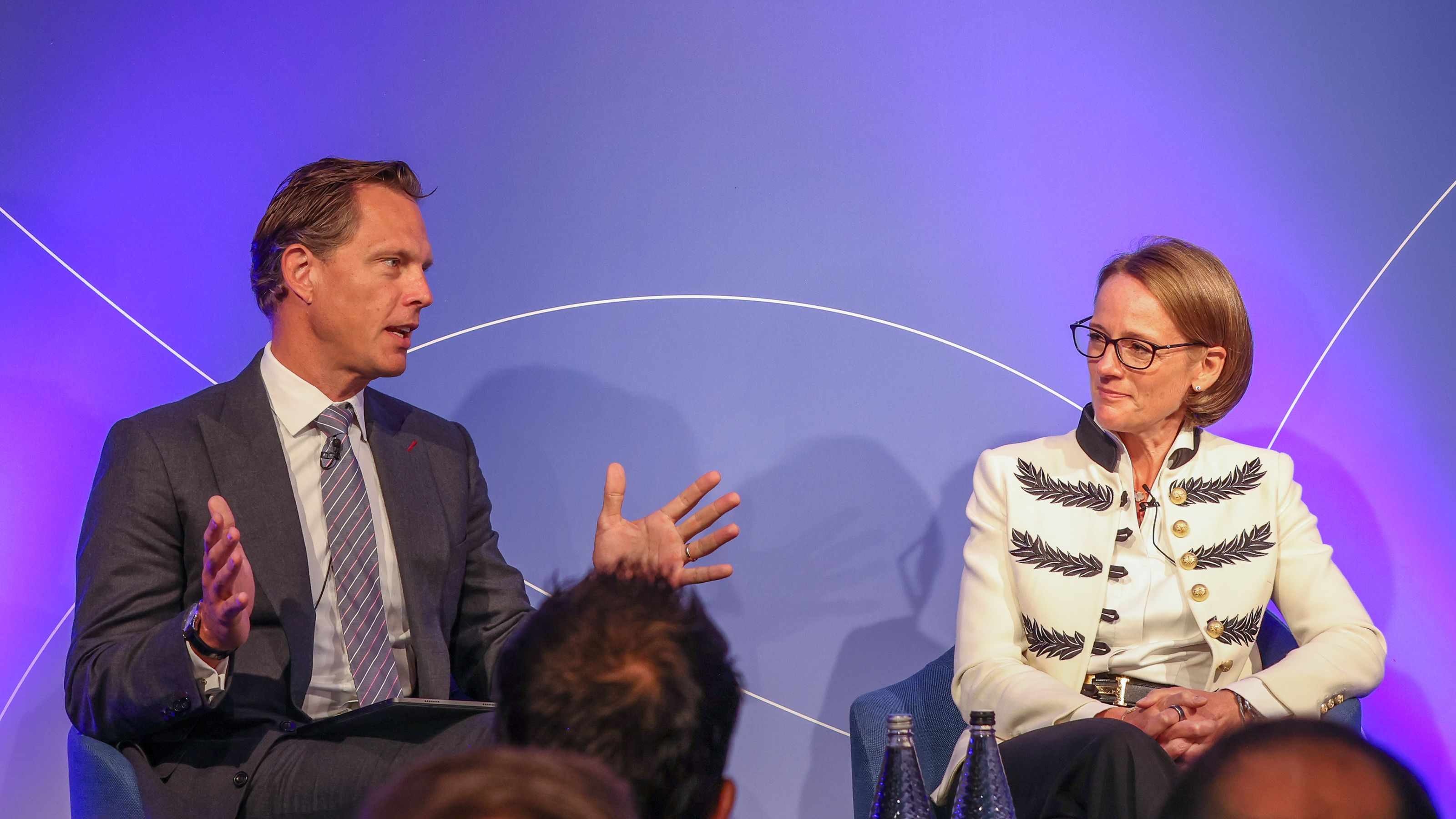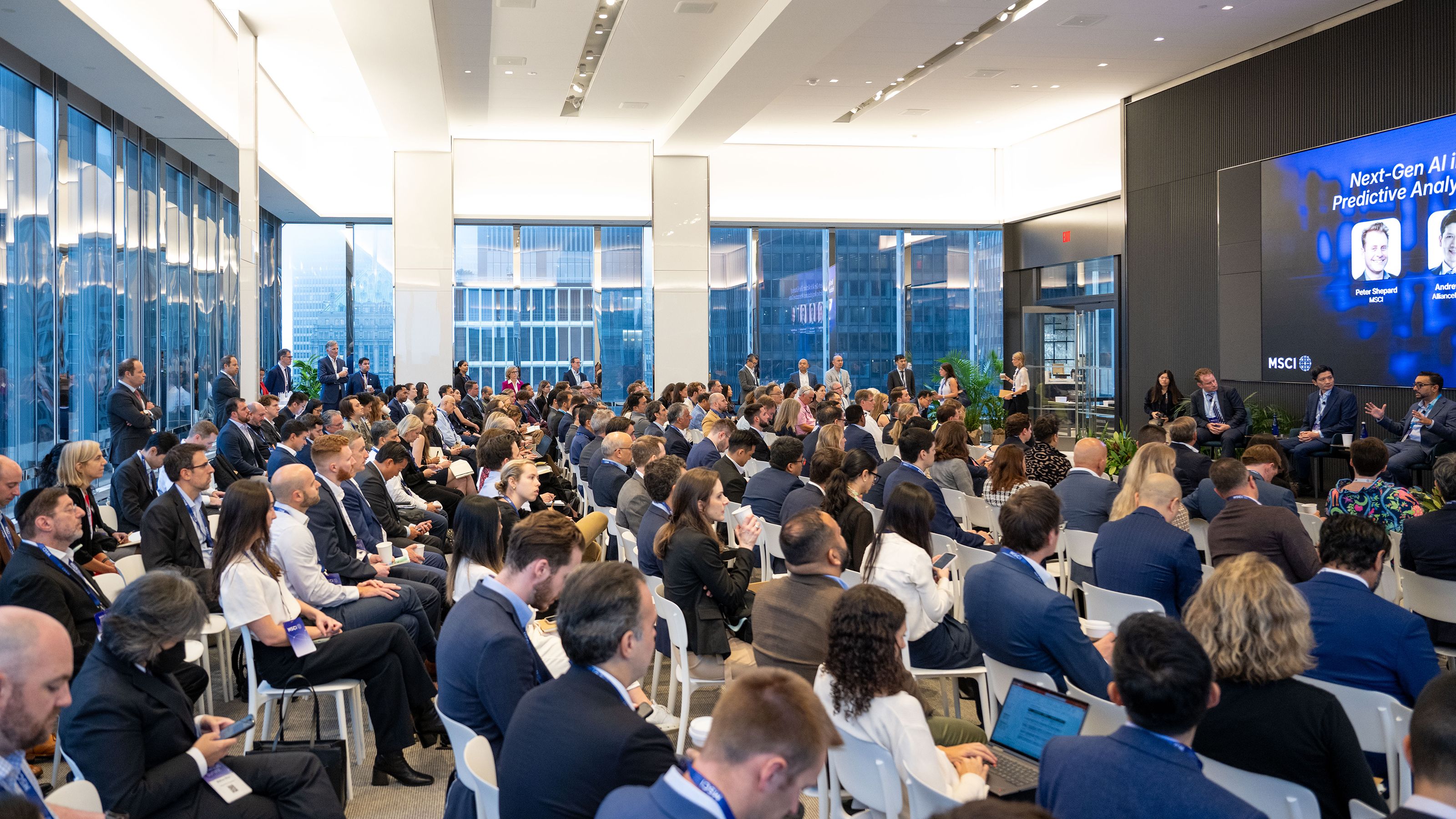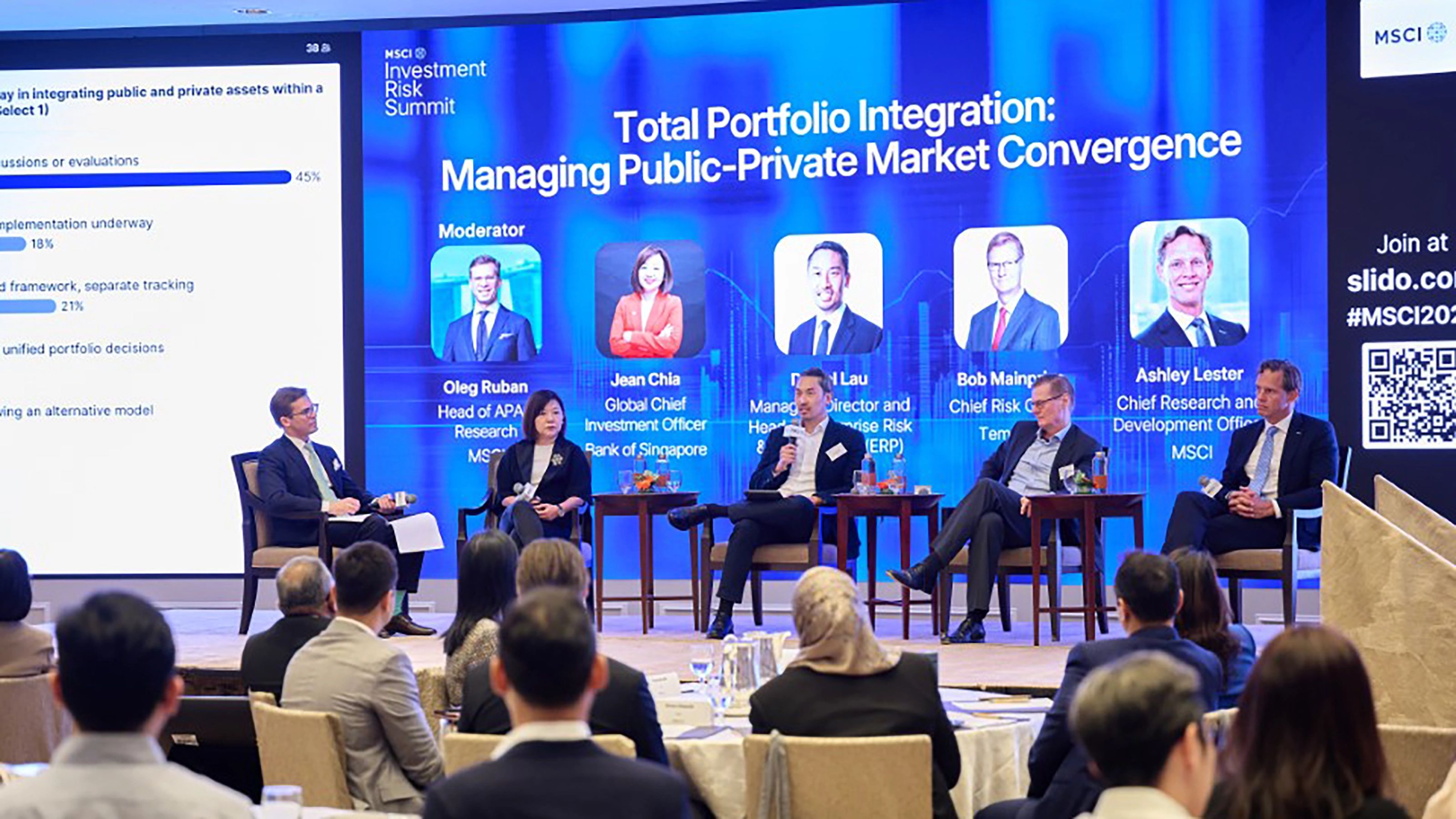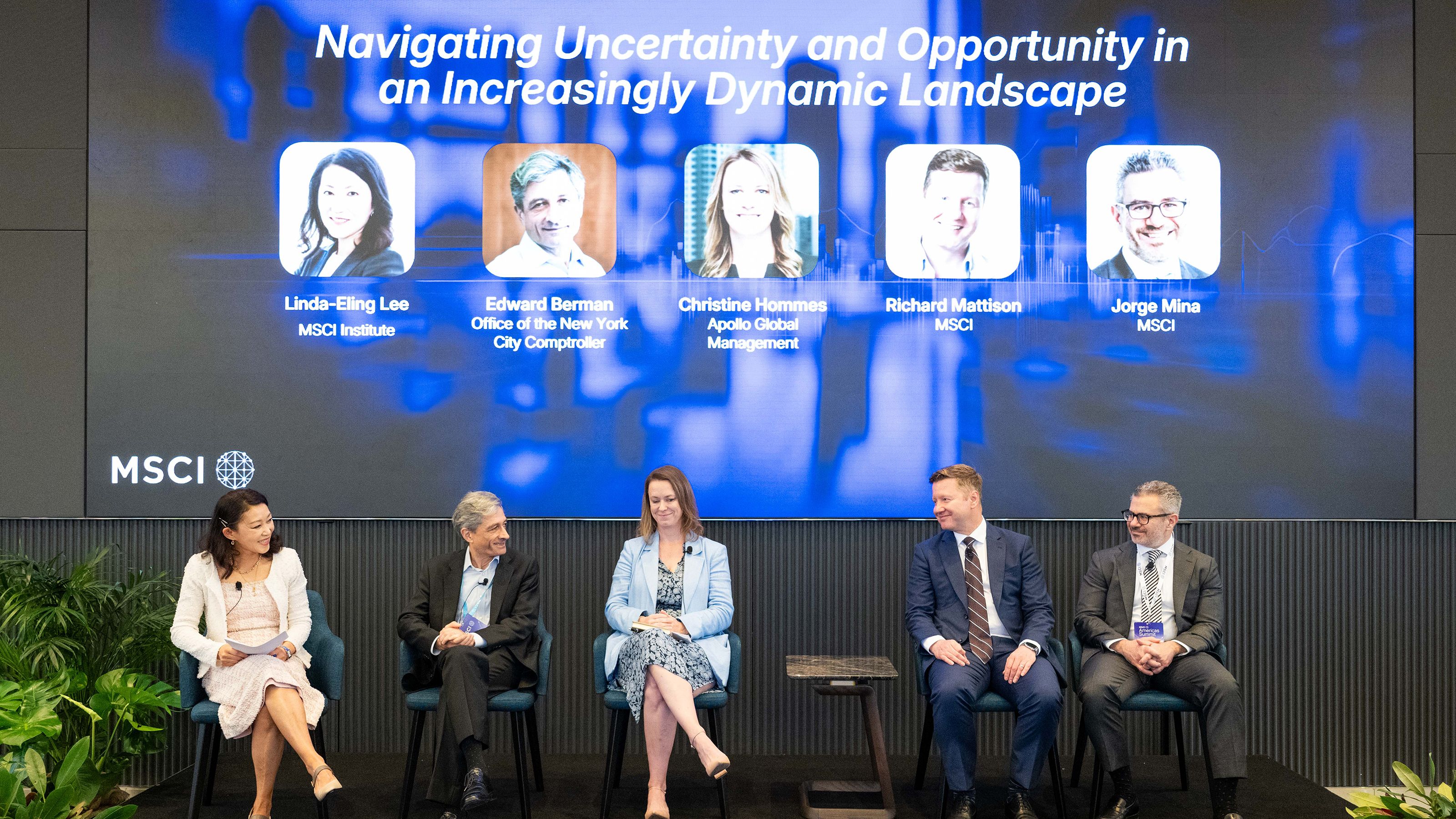Five Insights on Navigating Innovation and Resilience
- Traditional models under strain: At MSCI’s Investment Summits worldwide, CIOs and risk leaders shared that old frameworks are faltering under the stress of geopolitics, AI disruption, physical climate risk and the rise of private markets.
- Resilience requires new approaches: For investment leaders, the shift is from prediction to preparation. That means testing portfolios against scenarios, embedding AI and breaking down silos between public and private assets.
- Inaction carries costs: Extreme weather, liquidity strains and valuation gaps are already material. Leaders who adapt faster with sharper tools and richer data will be better positioned to identify opportunities and prepare for shocks.
— Henry Fernandez, MSCI’s Chairman and CEO
Technological disruption and the need for institutional resilience are forcing investors to rethink how they build portfolios and manage risks.
Those themes dominated MSCI’s Investment Summits, which gathered investment and risk leaders in New York, London, Sydney and Singapore. Discussions ranged from AI and geopolitics to private assets and the mounting costs of physical risk.
Opening the Americas summit, Henry Fernandez, MSCI chairman and CEO, said investors are facing “historic levels of economic uncertainty as well as historic transformations driven by asset shifts, advanced data and technology and the impacts of rising global temperatures.”
For investors, meeting this moment requires new frameworks, sharper tools and richer data. During the sessions held around the world, five themes emerged that capture how CIOs and risk leaders are adapting to overlapping disruptions in markets, technology and geopolitics.
Uncertainty is familiar to investors. What is different today is the speed of change and the difficulty of folding it into portfolio decisions. Ashley Lester, MSCI’s chief research & development officer, described the challenge as balancing the two fundamental pillars of long-run returns: institutions and technology. Fiscal burdens and shifting political norms are testing bond markets, while AI is reshaping equity growth prospects. “Juggling these fundamental forces and allocating across public and private markets requires new thinking in risk and portfolio management,” he observed.
As Sonja Laud, CIO of LGIM, put it: “Trying to forecast anything right now is senseless; preparation and scenario analysis is key.”
Takeaway: CIOs cannot rely on linear forecasts. Building resilience means testing portfolios against a spectrum of scenarios, from macroeconomic shocks and geopolitical tensions to liquidity strains and technology-driven disruption, and ensuring portfolios can adapt across public and private markets.

AI is moving quickly from pilots to practice. Investors see it as the most effective scalable way to process today’s volume and complexity of data. While AI-related stocks have surged,1 some CIOs argued that the long-term winners may not be the innovators building the tools, but the companies and allocators who deploy them effectively to sharpen decisions and widen margins.
One CIO described running an “AI brain” strategy since 2019, with most stock selection driven by the model but humans providing judgment where the model falls short. Others pointed to practical uses in monitoring exposures, drafting commentary and automating reporting. At MSCI, AI is already reshaping what is possible, from scaling geospatial datasets by more than 40 million assets to helping investors surface key indicators faster through AI Portfolio Insights. Looking ahead, some expect AI to eventually stitch together structured and unstructured data in ways that blur the lines between quantitative and fundamental analysis.
Takeaway: AI is not replacing judgment, but it is changing how judgments are made — faster, broader and with new dimensions of insight.

Allocations to private markets are climbing, with some institutions now allocating over 50% of their portfolios to private assets. But growth has brought strains, especially around liquidity and valuation. Delayed distributions in private equity are expanding the use of secondaries and semi-liquid vehicles, while private credit, now roughly a USD 1.6 trillion market, is emerging as a potential diversifier.
Valuation remains one of the thorniest challenges. Because private market performance data is smoothed and lagged, it’s difficult to compare strategies or run attribution. “Investors need transparency across asset classes and a consistent framework for evaluating all dimensions of risk,” said Luke Flemmer, head of private assets at MSCI.
Takeaway: Private assets are now essential, but blind spots remain. Investors need unified frameworks that bring transparency and consistency to liquidity, valuation and attribution across strategies to build confidence in portfolio decisions.

Physical risk has shifted from a future concern to a present financial driver. Extreme weather events, nature-related risks and trade tensions are intensifying, seeping into portfolios, loan books and insurance markets, and creating material financial impacts. “Physical risk is systemic, it’s affecting every asset across the world in some way, it’s nonlinear and it’s rising,” said Richard Mattison, MSCI head of sustainability and climate.
MSCI analysis shows that chronic hazards such as heat and acute events such as storms and floods could cost the largest listed companies globally USD 1.3 trillion in the next year through asset damage and lost revenue. Exposure is highly localized, with facilities and supply chains often more vulnerable than disclosures suggest. Insurance markets are responding with higher premiums and shrinking coverage, adding another layer of risk for the financial system.
Takeaway: Physical risk is no longer hypothetical. Incorporating asset-level hazard data, adaptation strategies and the cost of insurability into investment frameworks is becoming a much larger piece of the portfolio-management puzzle.

As correlations weaken and private allocations swell, traditional allocation frameworks are falling short. CIOs stressed the need for total-portfolio approaches, cross-asset risk budgeting, liquidity modeling and integrated analytics that span public and private holdings.
The risk function itself is also shifting. Once seen mainly as oversight, it is increasingly part of the investment engine. As Jorge Mina, global head of analytics at MSCI, explained: “The firms that succeed are those that integrate a risk culture directly into the investment process. Risk isn’t just compliance — it’s a driver of performance, shaping position sizes, capital allocation and the robustness of decisions.”
Takeaway: Resilience requires a total-portfolio perspective. Breaking down silos allows investment and risk teams to capture interdependencies, manage liquidity and prepare more confidently for the next shock.

Resilience today means moving beyond forecasts to scenario analysis, embedding AI into investment processes, bringing greater transparency to private assets, integrating physical risk into capital decisions and managing portfolios with a unified view.
As markets evolve, the real challenge for investors is how quickly they adapt their frameworks to harness innovation to capture new risks and position portfolios in a world where old models are increasingly insufficient.
Subscribe todayto have insights delivered to your inbox.
1 The MSCI ACWI IMI Robotics & AI Index is up about 31% YTD as of Sept. 26, 2025.
The content of this page is for informational purposes only and is intended for institutional professionals with the analytical resources and tools necessary to interpret any performance information. Nothing herein is intended to recommend any product, tool or service. For all references to laws, rules or regulations, please note that the information is provided “as is” and does not constitute legal advice or any binding interpretation. Any approach to comply with regulatory or policy initiatives should be discussed with your own legal counsel and/or the relevant competent authority, as needed.




